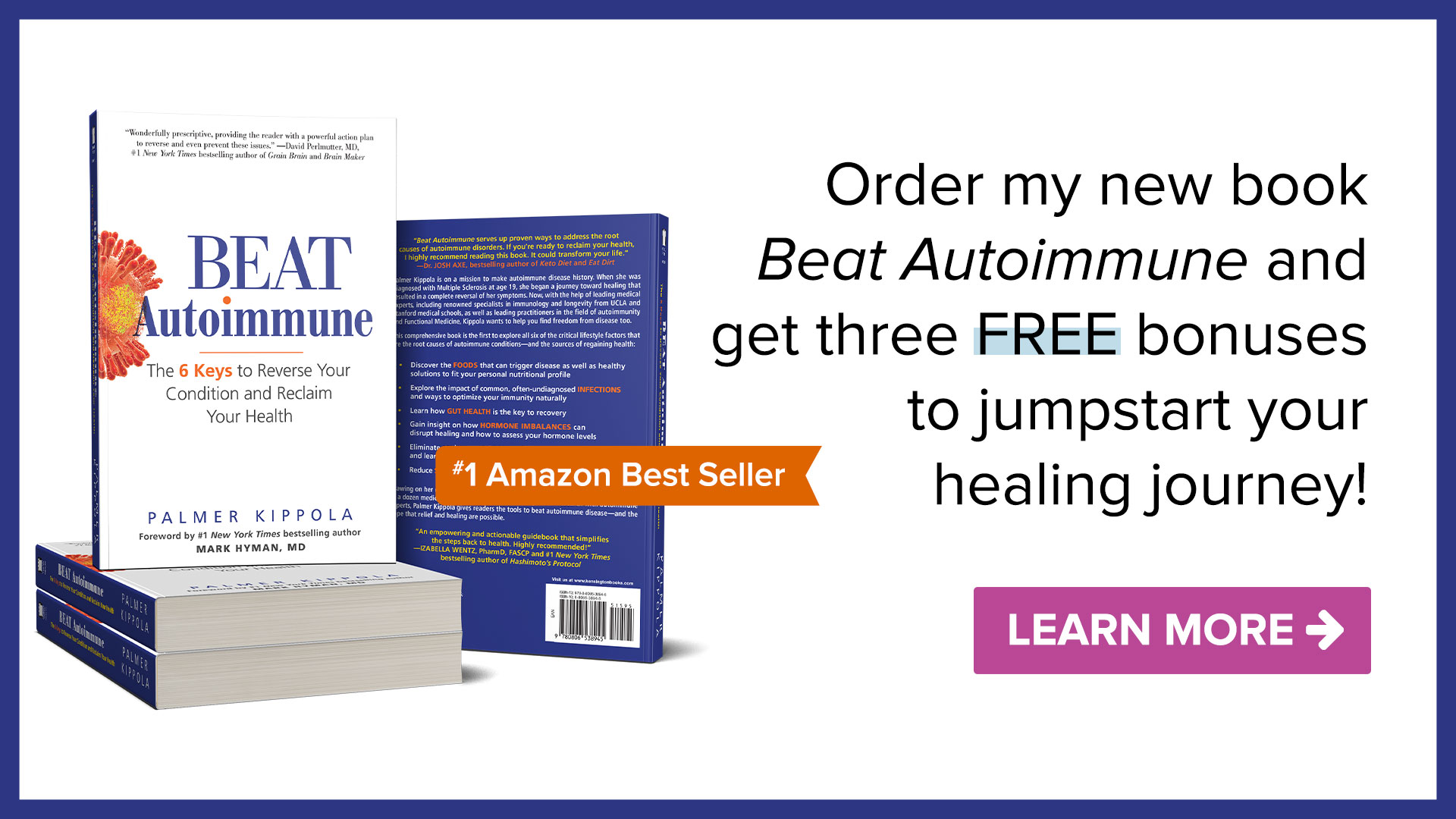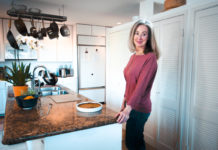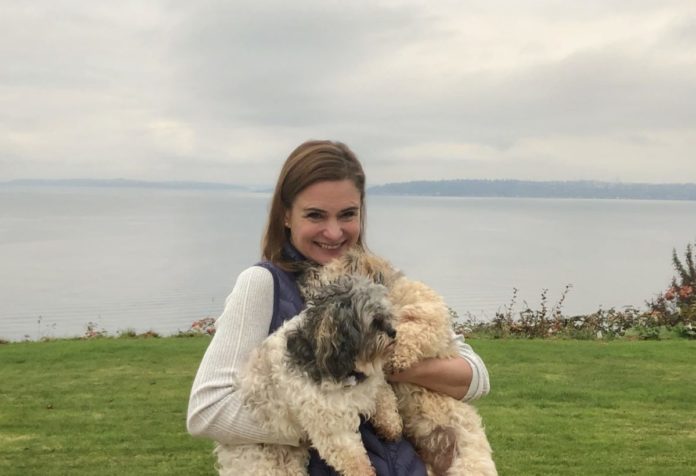
Step away from the sugar. Learn to read labels.
Better yet, don’t eat stuff with labels.
If I can beat autoimmune, you can too!– Hillery Nye
Early and Inherited Trauma Set the Stage
Significantly older than my two younger siblings, I grew up in two different versions of the same family. In the first version of that family, Family v.1, I was an only child, a mini adult who was folded into the lives of hippie parents. In the second version, I was a mini mom who helped raise kids and keep the peace in a chaotic household.
In Family v.1, my parents were college students collecting a variety of advanced degrees to avoid the Vietnam war. We lived in at least five cities in as many years, usually in various forms of subsidized student housing. We moved from Boston to Minneapolis to Seattle—and spent another year touring the cheap parts of Europe in a rusted-out VW bus.
Family v.2 began when my younger sister was born and we settled down in our first permanent home on a small island in Puget Sound, Washington. I was seven. We lived on the south end of the island, which was located under the plume of the Asarco arsenic factory. (Lawsuits would eventually close this factory, but while I was growing up grass simply did not grow in that poisoned soil. I remember having to wear rubber boots to school because the playgrounds were just fields of mud. I have no doubt that this exposure contributed to – or perhaps caused – my health issues later in life.
Family v.2 became increasingly tense over time. Unlike Family v.1, Mom and Dad were no longer a single set of parents, but two separate people living very different lives. Rarely home, Dad was a lawyer for the King County prosecutor’s office in Seattle, working impossibly long days, made longer courtesy of an extended commute by ferry. Most of those years, Mom stayed home to raise my siblings (who we referred to as “the Kids”) in relative isolation. I spent my elementary school and teen years co-parenting The Kids with Mom and trying to please and be perfect to avoid any additional conflict.
Despite a tense home, my parents were good parents, considering they really had no models for parenting themselves. Mom immigrated to the U.S. at age 12 as a refugee from World War II and was essentially raised by her older sister. Dad grew up in a family of secrets and silence. His father was shot during a robbery at a convenience store, and I’m not sure he—or his family—ever recovered.
Growing up, my parents distrusted Authority and the Establishment, which included doctors and Western medicine. Getting sick or injured was, in many ways, a sign of weakness. Being tough, powering through, and “getting back on that horse” were the orders of the day. Feeling bad was something you did in secret and in solitude. Talking about feelings—physical or emotional— was not done. My mom would say, “You can’t possibly complain because you’ve never been a refugee. We had nothing.”
Onset of Autoimmunity
The start of law school was accompanied by intermittent joint pain, trouble concentrating, trouble sleeping, and trouble staying awake. I figured it was simply a sign that I was a bad student without the stamina for study that all my superior classmates seemed to possess. By the time I graduated, I had developed several allergies that would trigger asthma and other odd physical reactions. I developed severe rashes on my face and chest whenever I was in the sun.
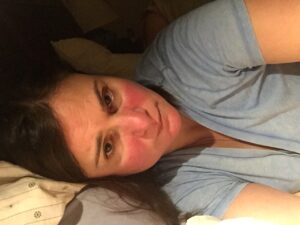
Intense fatigue started to interfere with my life. In search of a solution, I sought the help of campus doctors, who would inevitably prescribe steroids, antidepressants, sleep medication, or therapy to fix the problem du jour. All I really ended up with were piecemeal diagnoses and multiple side effects. My collection of autoimmune diagnoses included Sjogren’s, Raynaud’s and Hashimoto’s.
Medications mounted:
- For brain fog, I was diagnosed with ADHD, and given Adderall (a stimulant).
- For exhaustion, I took that Adderall.
- For the racing heart and anxiety that came with taking Adderall was given Xanax (a sedative).
- For the headaches that came from the Xanax, I was given Naproxen (a nonsteroidal anti-inflammatory drug or NSAID)
- For the stomach aches that came from the Naproxen, I was prescribed therapy;
- In therapy, I was told to spend “more time in the sun.”
- For the “butterfly” rashes that inevitably came from “spending more time in the sun,” I was given corticosteroids (strong anti-inflammatories).
- For the thinning skin around my nose and cheeks that came from the corticosteroids, I was referred to a dermatologist, who prescribed Botox (botulinum toxin).
- For the anaphylactic shock resulting from Botox, I was prescribed epinephrine injections (stimulant).
- For the mysterious bruising on my legs and around my eyes, I was diagnosed with ITP and given steroids. [Palmer’s note: ITP is an autoimmune condition affecting blood platelets and causes platelet levels to plummet, which is dangerous since it can result in uncontrolled bleeding.];
- Taking steroids gave me brain fog… and the cycle started again.
Of course, this is just an illustration of the many ailments that were never cured by medicine…just temporary band-aids for persistent problems.
I can see now the connections. In addition to the Sjogren’s, Raynaud’s and Hashimoto’s, I had the textbook signs and symptoms of lupus. All the odd illnesses, the rashes, the chronic fatigue, the mind-numbing nerve pain, the unrelenting bone deep fatigue and coughs and colds…and all the infections that resulted from those coughs and colds…, they were shameful. Surely, I came from sturdier stock. If I were better and stronger and could just get back up on that damn horse – then I would be just fine.
It wasn’t until my mid-40s when my pretending failed. During a routine exam, my doctor flipped through my chart. “When was your latest ANA [antinuclear antibody] test?” she asked.
I had no idea what she was talking about. “ANA?
“Yes. For your lupus.”
What?! I had never heard of lupus and was shocked. None of my doctors had ever mentioned it. Sure enough, an ANA test confirmed the diagnosis. I had lupus – a mysterious autoimmune condition; one that causes widespread inflammation and tissue damage. I felt ashamed.
I followed doctor’s orders. I took “new and improved” steroids, all prescribed in an effort to protect my joints, my kidneys, and my skin from further deterioration. I soon became “eligible” for experimental lupus treatments and drug trials. These options were depressing at best… and I had enough challenges at the time. My joints swelled further and the pain was intense.
Bad to Worse: Stressors Mount
At the same time I was diagnosed with lupus, the rest of my life fell apart. I had to face the brutal reality of my personal life and the failure of my marriage. This man was an emotionally abusive narcissist. Worse, he had gambled away all the assets we had, grinding my sense of safety and security into dust.
Everything that I had worked so hard to build crumbled: marriage, finances, my business, and finally, my health. I was in an extremely emotional and vulnerable place. Crippling exhaustion set in. As I filed for bankruptcy and divorce, I went back to the one thing that still remained in my name: a cabin on Vashon Island. In that cabin, I found myself sleeping for 20 hours a day. Even there I didn’t feel safe and my body continued to deteriorate. I was defeated and devastated and struggled to get through each day.
I got sicker. Steroids, ointments, antidepressants, and prescription sunscreens were no longer enough. In addition to the various pharmaceuticals I was already on, I added methotrexate, Imuran, and chloroquine to get lupus under control.
To be clear, these are strong medications:
- Methotrexate treats cancer;
- Imuran prevents organ transplant rejection;
- Chloroquine prevents/treats malaria.
At first, this combo made me feel better, but the problem with these medications is that they have harsh “side” effects. They obliterated my immune system and I lost the ability to defend my body from infections. [Note from Palmer: “side effects” is a marketing term used by drug companies to make them seem inconsequential. In reality, these are harmful and direct effects of medication, many of which we know can trigger autoimmune conditions and cancer.]
Five years ago when I got a bronchial infection, I could not shake it on my own. Treatments for pneumonia failed. Soon I was sent to various specialists, where a spinal tap confirmed that I had spinal meningitis.
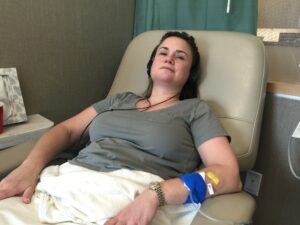
The months that followed are a blur. I slept 20 plus hours a day. I took a near-permanent leave of absence from my law practice. My head hurt so badly I didn’t care. My brain was on fire. On good days, I would listen to the radio, a podcast, or an audiobook while I faded in and out of sleep. I don’t remember the bad days. I think that’s a small mercy.
Saved By My Dogs
During the nine months it took to fully recover from spinal meningitis, I had to face several terrible truths: 1) lupus is serious. I could not “ignore it” or “tough it out” and “get back on that horse;” and 2) lupus would kill me. The only question was, what would kill me first: the disease or the drugs prescribed to treat it?
Meantime, life continued. I leaned in to friends and family to care for mundane daily duties; but I had two big responsibilities that could not be delegated: Ricky and Lucy.
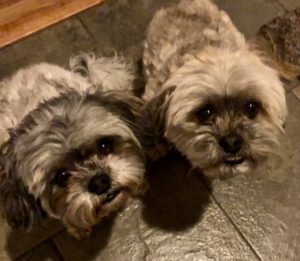
Ricky and Lucy are two caramel-colored lap dogs—a combination of Havanese, Shih Tzu, and Poodle—that look like Ewoks from the Star War movies.
I had adopted them as puppies in a moment of weakness over a decade ago, worn down by the persistent pleas of my sons who swore they would do anything to have a dog. Those boys became men, long removed from their childhood promises, but those dogs still had needs. In the midst of my daily battle to sit up and breathe, those damn dogs sat on my bed, every day, waiting for me to get up and take them out.
I had little choice but to walk them.
First, we made it to the end of the driveway. Then, to the end of the block. Slowly, eventually, we walked a little further. Soon it was around the block. Twice. And then one day, I was walking without throbbing pain in my head. I was breathing crisp, clean air. The sun was setting, and everything was bathed in gold and pink, red and purple. I was still here in the world. And the world was beautiful.
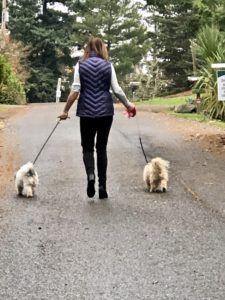
That night, I could feel myself getting better. My joints were a little less stiff, a little less swollen. Walking was a little less painful. My rash was a little less itchy. My face was a little less sensitive to the light. My dogs were bringing me back to myself.
Taking My Health Into My Own Hands
During this time, I had stopped taking all the “advanced” drugs that my doctors had prescribed to treat the symptoms of lupus. They were just too much for my body to handle—so I listened to my body and took myself off the meds.
Without them, I actually felt better, and I began to reassess my relationship with lupus and to question the treatments I received: Had those medications been worth it? What was the result? A brain on fire. Organs stressed to the point of failure. Forty pounds of puffed-up steroid weight. Isolation. Depression.
Ultimately, as I recovered from meningitis, I had to confront what I had been told by doctors, but didn’t want to accept: There is no cure for lupus. No magic bullet or foolproof regimen will save the day. There is just experimentation. Educated guesses to “manage” a disease. In other words, doctors throwing darts in the dark to see if they can find a target.
Why should I presume that a doctor’s dart throwing is a better approach to managing lupus than any and all other options? Surely, I needed to investigate, to question, and throw a few of my own darts into that darkness.
I began by going to a therapist because I was depressed and I feared learning more about lupus would be even more depressing. Therapy was harder than I expected. In therapy, I had to take a hard look at myself. It wasn’t pretty. I had become angry, fearful, and resentful. And those toxic emotions had taken root over the course of a lifetime, not simply during the difficult events of the last few years. Week by week, I peeled back the layers of dark emotions, each time learning to do so with a bit more compassion, a bit more forgiveness, and a bit more willingness to consider alternate endings and ways of looking at the life I’d been leading. Most importantly, I learned the lesson my therapist reminds me daily: anger is like swallowing poison and waiting for someone else to die. And it was time to stop swallowing my own poison.
I started to practice forgiveness. I began by accepting my small failures and bad choices, acknowledging that I did the best I could at the time with the tools and information I had available to me. Then I started going broader and deeper. I’m still deep in that practice and may never be done. The work is hard – but essential, liberating and healing.
This ability to forgive, this willingness to be lighter in spirit and to embrace a new version of love led to unexpected outcomes. Soon, I found myself in love with a quiet man from Iowa, who is solid, honest, gentle, and kind. For the first time in my life, I brought my whole self to the relationship. We married two years ago, and our relationship has been a persistent source of delight and comfort.
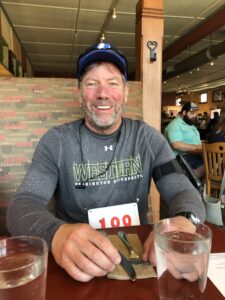
During this time, I realized that the health of my mind, my heart, my soul, and my body were intertwined. I began looking at autoimmunity more holistically, seeing it as conditions that do not exist separately from the rest of me but as a reflection of my overall health. Thus, to heal, I would need to find ways to improve my overall health.
I read everything I could about mind/body health, theories of illness, generally, and autoimmune disorders in particular. With the benefit of therapy, I could see lupus as a challenge, not an indictment. I became a scientist, who could look at this one part of my larger self with curiosity and a willingness to experiment.
This path led me to Palmer Kippola’s life-changing book. Beat Autoimmune offered important information and encouragement at a perfect time in my life. I needed to hear the science, the stories, and the very practical advice so that I could make real changes in my life. I needed to know that I could, indeed, heal myself completely.
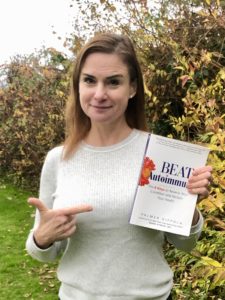
Upon Palmer’s recommendation, I immediately started the 30-Day Food Vacation. This concept did not seem like much of a vacation to me, so I enlisted the help of a nutritionist and my sweet husband. Together we purged the pantry of sugar and processed foods. This was a shocking exercise, because it required me to look closely at the ingredients in all the foods I regularly ate. It was also a bit emotional, because I was throwing away “perfectly good food,” which was verboten on my mother’s side of the family, who had almost starved to death during WWII. But if I was going to own this experiment, I needed to embrace it fully.
The first three weeks of the Food Vacation were horrible. I had headaches and sugar cravings and generally hated everyone. My nutritionist, Kara Krause, MA, NTP at Innate Vitality in Seattle reminded me this was all temporary and provided various supplements, like magnesium, zinc, and calcium. Kara also reinforced the idea that this “vacation” was an essential part of my experiment: What was I craving? How was I feeling? Where was my energy? What was new?
Before the Food Vacation, I had no idea I was so addicted to sugar and processed foods—and no idea how much I would struggle with this new way of eating. In the past, I had considered myself a “healthy eater.” I’d have salads with croutons and dressings loaded with sugar and canola oil, wash it down with a Diet Coke and pat myself on the back for eating well!
At the start of the “vacation,” I was about 40 pounds overweight and trying to make peace with my bloated body. Doctors told me this is was “just what middle age and lupus look like,” and that the medications I took made aerobic or high-impact exercise impossible. They cautioned me against running, in particular, as that could hurt my swollen joints and damage tendons that were brittle from years of steroids. The message I heard at the time was that I just had to accept being fat.
But my new way of thinking let me see beyond that construct. I was learning to listen to my body, to do what felt right. And moving felt so much better than sitting still. So, I started out with gentle exercise, like beginner Pilates and yoga. Soon my husband joined me, and we found ourselves getting stronger, leaner, and more energetic by the week.
Even after the Food Vacation, I am still learning what foods are friendly and which are foes. Sometimes my body can tolerate foods that are a bit inflammatory for me, like nightshades; other times I can feel these foods in my joints and bloated belly. This is my body’s warning system telling me something is off. To put things back into balance, I have to consider everything, from diet and sleep to exercise and stress.
Stress is my most significant challenge these days. I still overcommit to others and let my commitments to myself (like sleep!) fall to the wayside. I am making a conscious effort to track my time and energy so that I can identify patterns of behavior that help or hinder my health. Currently, I am experimenting with meditation. Meditation reminds me of the early days of my Food Vacation. I hate it. My head is a busy and loud place and the silence does not come naturally. But I sense there is something to it—so the effort continues.
My experiment in reversing lupus and other autoimmune conditions through diet, stress management, and exercise has exceeded all my expectations. I wake up with energy. My joints do not hurt. I no longer have a puffy moon-face. My mind is back to its former, reliable state. I’ve lost all the excess weight, and I’m back to the size 6 I wore a decade ago. I am slowly weaning myself off all lupus meds under the supervision of a supportive rheumatologist.
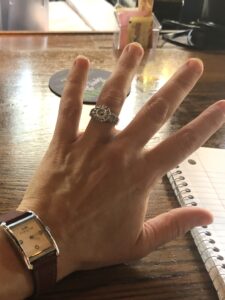
I have a renewed love for my body. I no longer think of it as a separate, failing part of me, but as the warrior that is me. Mostly, I have learned how to take good care of myself—body, mind, and spirit. And I still walk my dogs, with gratitude and delight, every day.
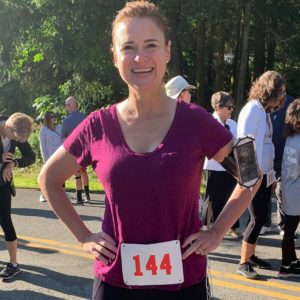
My Top Recommendations:
- Listen to and honor your body. It’s the only one you’re ever going to have, and you know it better than anyone else. Symptoms are not to be avoided or ignored but embraced as friendly messages letting you know something is out of balance.
- Step away from sugar. You can do it!
- Learn to read labels. Better yet, don’t eat stuff with labels!
- Learn to cook. It can be a fun and creative way to spend an evening, to create community, and to express the love you have for others—and yourself.
- Know you can do it. And seek help from experts who can accelerate your time to complete recovery.
I am so grateful to be alive and there for my sons! (Photos courtesy of Hillery Nye)
As Hillery suggests, what are your symptoms or challenges saying to you? If we get quiet, listen to our bodies, and trust our intuition, we may already know what we need to do. Very often there is a call of the soul we need to heed.
Take good care!

p.s. Want my help beating an autoimmune condition and thriving? If you live the U.S. and are ready, willing, and able to invest in your best health, I offer Functional Medicine Total Health Transformation Programs over Zoom. I collaborate with naturopaths who are expert in resolving chronic infections, toxic burdens and hormone imbalances which are almost always part of the autoimmune puzzle. Together we provide comprehensive, customized treatment plans, and collaborative, caring support. Book a complimentary 30-min discovery call to discuss your goals and how we might work together. If you’re truly ready to invest in your best health and life, I’d love to talk with you.




